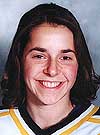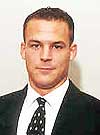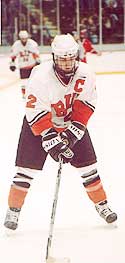This is the first NCAA sanctioned Division III Women’s Ice Hockey Championship. There were two prior national tournaments put on by the American Women’s College Hockey Alliance (AWCHA), both won by Middlebury — the first one in Boston, the second one in Rochester, N.Y.
The NCAA wasn’t even planning on sanctioning this championship for a few more years. But the explosive growth of Division III women’s hockey allowed them to move up their timetable, and the AWCHA was glad to “pass the torch” after nurturing it for two years.
However, the NCAA won’t be recognizing those prior tournaments when it comes to its record book. As far as they care, there have been no prior national champions. Thus, this year’s titlist will be the first. And every record set in the tournament will be new.
Bowdoin, the NESCAC champion, Elmira, the ECAC West champion, Manhattanville, the ECAC East champion, and Gustavus Adolphus, the MIAC regular-season champion, will all congregate in Elmira, N.Y., at the Murray Athletic Center, commonly known as The Dome, this Friday and Saturday.
The semifinal matchups will pit Bowdoin against Manhattanville at 4 p.m. Eastern and Gustavus Adolphus against the host, Elmira, at 7:30 p.m. The consolation and championship games are the next day at the same times, respectively.
Tickets for both days are $20 for adults and $10 for students. One-day tickets are $12 for adults and $6 for students. For more information, call (607) 735-1730.
Sorry, Virginia, There Is No Middlebury
At the start of the season, you probably couldn’t get Las Vegas to accept a bet on Middlebury winning the national championship, such a sure thing it seemed. Well, six months later, the Panthers aren’t even in the Frozen Four. Times do change, and the rest of Division III women’s college hockey has caught up.
Instead of Middlebury, we have four great teams, any of which could easily take the crown. Two of those teams, Bowdoin and Manhattanville, beat Middlebury this year. One of those teams, Elmira, beat Manhattanville. The Western team, Gustavus Adolphus, is returning to the Frozen Four. So, don’t worry about the absence of Middlebury. This is a wide-open tournament guaranteed to rock The Dome.
As Bowdoin coach Michelle Amidon says, “There’s a reason these four teams are here. You can’t take anyone for granted.”
Let’s Get This Out Of The Way
Since this is an issue that won’t go away, we are going to mention it now, and then we are not going to write another word about it the rest of the weekend.
We are talking about Wisconsin-Stevens Point not making the tournament. Understand something. There was only one slot open for the Pool B teams. The two contenders were Stevens Point and Elmira. Gustavus Adolphus and Middlebury were Pool C teams. They had nothing to do with Stevens Point being left out. St. Mary’s, Bowdoin, and Manhattanville got automatic bids. They had nothing to do with Stevens Point being left out.
The problem is there was one Pool B slot available, and two great teams vying for it. People argue, how could you leave a team that has one loss and won its conference championship out? Well, I hate to break it to those folks, but Elmira also only had one loss and won its conference championship.
There’s a reason these four teams are here. You can’t take anyone for granted.
— Bowdoin coach Michelle Amidon
The selection committee uses PWR and RPI as two prime indicators. In both of those, Elmira was ahead of Stevens Point. True, it is hard to compare East vs. West when there is so little crossover. But, some sort of comparison had to be used. Yes, Stevens Point beat Gustavus Adolphus and St. Mary’s, but Elmira beat Manhattanville. It was a close call, and no matter who was left out, people would have been screaming.
The selection committee has to work within the rules and guidelines setup by the NCAA. Something else a lot people do not realize: This Pool A/B/C stuff is for every sport in Division III. Trust me on this one, sports like basketball, soccer, and lacrosse have suffered a lot more with this system than hockey has.
There were seven teams deserving of going to the women’s hockey tournament. Only six slots were available. Someone had to be left out.
The NCAA, for various reasons, has decided on this selection method for Division III. Don’t expect it to change soon. If you want to be upset at someone, be upset at the NCAA. Don’t be upset at the selection committee, which made the correct decision within the confines it were told to operate. Don’t be upset at Elmira. It had as much right to be there as Stevens Point did. Don’t be upset at the other five teams. They made it in according to the rules set forth within the pools they were grouped in.
For those who think there is some kind of Eastern conspiracy going on, consider this — the chairman of the selection committee is the athletics director for Stevens Point. If there was a conspiracy, the decision would have been the other way around.
And for those writing us that there should be some sort of investigation and this should be taken to a higher order, I get the feeling that there are a lot more important issues confronting this country — did everybody suddenly forget we are fighting a war — for any “higher order” to care one whit about college hockey.
Is it unfair that Stevens Point (or Elmira if it were the other way around) was left out of the tournament? Yes. Sometimes life is unfair. Life was very unfair for a whole lot of people on Sept. 11. Let’s keep some perspective here, folks.
Now, drop the puck!
Bowdoin Polar Bears (23-3-1)
Some people may think that Bowdoin snuck up on everyone and is the surprise entry in the tournament. However, looking back on its season, it is no surprise at all.
The Polar Bears finished 13-2-1 in the NESCAC, where their only two losses came at the hands of Middlebury by one goal each, one in overtime. No shame there. Besides, they beat Middlebury when it counted most, in the NCAA play-in game, 2-1, in a game some said was one of the best this year, men or women.
They ran the tables in the NESCAC playoffs, beating Amherst 4-0, Colby 5-1 and Williams 2-1. In non-conference games, they went out west and swept the opposition, beating St. Thomas, Wisconsin-River Falls, and fellow Frozen Four participant Gustavus Adolphus, all by the same 4-3 score. Their only other loss came to Division I opponent Boston College, 4-1.
Bowdoin sports one of the best players in the country, All-American Shelly Chessie, and arguably the best defenseman, Kirsti Anderson.
Chessie is the complete package. She has speed and grinds it out in the corners. “She generates a lot of opportunities to score,” Bowdoin coach Michelle Amidon says. “[Tuesday, against Middlebury] she scored once and assisted on another.”
Her stats, though impressive, may not be as high as others in the country with 22 goals and 28 assists for 50 points, but she is well respected by the opposition.
Says Manhattanville coach Rick Seely, “Points aside, she has talent that nobody else has.”
There is no question who the quarterback on the team is, and that’s Anderson. Despite being a freshman, she’s every coach’s dream blueliner. Anderson is big, strong, and an all-around player.
“She’s a very composed player,” Amidon says. “She reads the play very well.”
Anderson is also the second leader scorer on the team with a 12-19–31 line. Bowdoin was fortunate to fight off St. Lawrence and get her to attend the Maine school.
Backstopping the Polar Bears is Emily McKissock, who has played in 23 of the team’s 27 games this year. The junior has a .933 save percentage. When asked what her style is, Amidon chuckled. “She has a unique style. We call it the Emily McKissock style.”
Those are just some of the stars. This team has depth and loves to play a physical game. They play three lines regularly, and it doesn’t matter who is up for the power play or penalty kill. Speaking of the power play, Bowdoin has the second best in the country with a 26.7 percent success rate, and the third best penalty kill at 93.9 percent.
If anybody thinks this team is a surprise entry, they are going to find themselves very quickly on the losing end.
Elmira Soaring Eagles (24-1-1)
When you mention Elmira, two things immediately come to mind — first-year program and All-American Laura Hurd.
It’s players like Hurd who made it possible for this first-year program to be so successful. With just two non-freshmen on the team — forwards Michelle Rennie, a sophomore, and Teegon Black, a junior, both of whom transferred from Division I Mercyhurst — they needed production in a hurry.
And they got it from Hurd, who led the nation with 72 points, split evenly with 36 goals and 36 assists, with a points-per-game average of 2.77. Charissa Gawant, taking advantage of her playmaking ability, was sixth in points per game at 2.04 with a 15-38–53. Those are just the top two scorers on a team with the nation’s highest goals per game at 6.46.
Elmira doesn’t have to worry too much about outscoring opponents, as it lets up only 1.31 goals per game, thanks to Kristin Lillie’s second-in-the-nation 0.67 GAA and a .941 save percentage. She splits duties with Edith Racine who has a .932 save percentage.
Helping Lillie and Racine out on defense is 5-foot-10 Julie Clune, an aggressive and mobile player, All-American LeAnne Denman, who also got 18 goals and 18 assists for 36 points, and Jenelle Bauer.
Either Elmira isn’t afraid to play the physical game or overexuberant youth has resulted in a 10.4 penalty minutes per game average, fifth highest in the country. But the Eagles also sit fifth in penalty killing at 92.7 percent. On the power play, Elmira has a modest 18 percent success rate, far below the other three teams.
Elmira lost its third game of the season to Plattsburgh, 2-0. Since then, the Eagles have never looked back, putting together the nation’s longest active unbeaten streak at 23 games (22-0-1), including a 3-0 win over Manhattanville on the road. Other key wins came against Plattsburgh (2-1, 2-0, and 4-3 as well as a 2-2 tie), RIT (2-0), and Williams (4-2).
The men’s team gets a great deal of support from the local community. However, it is now the women’s turn, and the Southern Tier fans are ready to throw their support behind the female Soaring Eagles this weekend. With emotions sure to be running very high in their first game because they are playing the only Western entry in the Frozen Four, Gustavus Adolphus, The Dome may be rocking and rolling like never before.
Gustavus Adolphus Golden Gusties (22-4-2)
The only repeat team in the Frozen Four, Gustavus Adolphus had a bit of a hiccup to get back. The Golden Gusties were the clear cut regular season MIAC champion with a 17-0-1 record. However, they were upset in the conference tournament final by second-place St. Mary’s, 2-1.
Yet they still got to host St. Mary’s for a repeat game in the first round of the NCAA tournament. This time, the Golden Gusties prevailed with a 2-0 victory. This gave them a trip to Elmira to face the host team.
The star of the team is once again Sarah Moe, now a senior and newly crowned AHCA National Player of the Year. She has 30 goals and 25 assists for 55 points, including seven power-play goals. Her 1.96 points per game mark was seventh best in the country. Senior Kenzie Stensland has 40 points with 20 goals and 20 assists, including six power-play goals and four shorthanders, followed closely by Ann Katz (18-19–37) and Katie Deschneau (17-19–36).
As you can see from the power-play production of Moe and Stensland, they have a strong unit that is 26.7 percent successful. This puts them in a tie with Bowdoin in that category, a hair above Manhattanville. While shorthanded, Gustavus is the worst of the four with a 89.6 percent rate.
Sophomore goalie Molly O’Donnell returns to share the netminding duties. This time, it’s with freshman Anne Kautzer. O’Donnell has a 0.76 GAA, third best in the country. They get help defensively from All-American Ellen Doyle.
Last year, Gustavus had the largest scoring margin of any team in the Frozen Four. That’s not the case this year, as Manhattanville and Elmira are ahead, but considering the Gusties’ schedule, and being fifth best in the nation with a margin of 3.71, they are still impressive.
Speaking of their schedule, it is probably the toughest among the four. Outside of their conference, they played Stevens Point (a 4-3 loss), Bowdoin (a 4-3 loss), Middlebury (a 5-1 loss), and Williams (a 1-0 win). So, the Gusties are definitely battle hardened.
The question is, will those games better prepare them for the intensity of this weekend, or were those losses indicative of where they stand versus that sort of competition?
They will find out soon, getting thrown to the Murray Athletic Center wolves the first night.
Manhattanville Valiants (22-1-2)
The women’s team started up the same time as the men’s team, so that means this is the third year for their program. Like the men, they have improved every year, but unlike the men, they find themselves in the Frozen Four after edging RIT, 4-3, in the ECAC East championship final.
Like Elmira, Manhattanville also has a freshman All-American, Cherie Stewart. When Stewart is on top of her game, there are very few who can match her talent. She scored 31 goals and 16 assists for 47 points.
However, it is not all Stewart, as Manhattanville coach Rick Seely explains, “Once in a while, Stewart makes a spectacular play, but generally we’re a balanced attack,” he says. “Everybody gets involved.”
That balance comes from Stewart’s linemate, Nicole Blais, another freshman, with a 14-10–24 line. In between them in the team scoring list are the Annunziato twins, Annie (13-29–42) and Ali (14-25–39), Melissa Hawkins (18-19–37), Kristin Sahlem (13-20–33) and Melanie Grover (9-18-27).
Though Manhattanville splits duties between its stay-at-home goalies, All-American Nicole Elliott may be the better of the two. Also a freshman, Elliott has a national leading save percentage of .954 and third best goals against average of 0.80.
The “other” netminder isn’t too shabby either. Renee Kirnan has a 1.31 GAA and .925 save percentage.
Seely plans to continue using both goaltenders, saving Elliott for the final day. “Kirnan will start the first game. Elliott will play Saturday no matter what happens Friday.”
The Valiants are the team that finally stopped Middlebury’s streak by a 4-1 score. But then, the very next day, probably because they were still on cloud nine, they lost to Elmira, 3-0, their only defeat of the year. They tied twice, both by 2-2 scores, against Southern Maine and RIT.
Manhattanville faces Bowdoin in the first semifinal, and special teams stand out. The combined special team rating has Manhattanville at 65.2 and Bowdoin at 64.9. This could be the best game Friday, but it may leave the winner banged up for the following night.
Despite being a third-year program, Manhattanville is still a young team with no seniors and five juniors. However, that has not been a problem for them.
“Our leadership has carried us the most,” Seely says. “Even though we’re young, we have great leadership. We have no problems off the ice.”

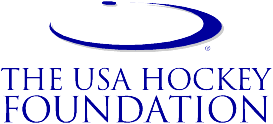
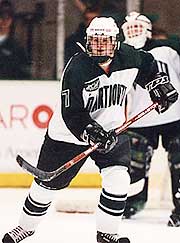 Carly Haggard, F, Jr., Dartmouth
Carly Haggard, F, Jr., Dartmouth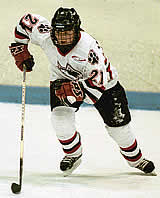 Brooke Whitney, F, Sr., Northeastern
Brooke Whitney, F, Sr., Northeastern